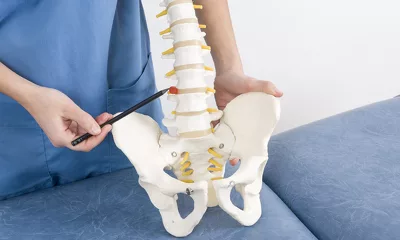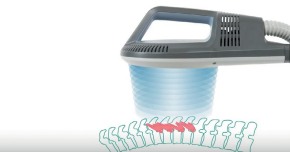Disc Prolapse is a musculoskeletal disorder characterized by displacement of the inner part of the intervertebral disc with rupture of the fibrous ring (its outer sheath) and may be accompanied by spinal pain.

Disc Prolapse is a musculoskeletal disorder characterized by displacement of the inner part of the intervertebral disc with rupture of the fibrous ring (its outer sheath) and may be accompanied by spinal pain.

Disc Prolapse (spinal disc herniation, intervertebral hernia, intervertebral hernia) is a bulging of the nucleus of an intervertebral disc into the spinal canal after the integrity of the fibrous ring (the outer part of the disc) is compromised.
Disc Prolapse (slipped disc) is a widespread medical problem that impairs a patient's quality of life and is a dangerous disease. Despite this patients are afraid of the surgery do not go to doctor. But more often than not with timely treatment, it is enough to use modern methods of non-surgical therapy.
Disc Prolapse are distinguished according to the concentration of the lesion and the degree of clinical manifestation
It's time to take care of your spine, find the cause of your back pain and restore physiological harmony. This diagnosis is not a reason to panic, but you should not consider it an insignificant thing to overlook either.
The basis of successful treatment of intervertebral hernias is the restoration of mobility in all segments of the spine, especially with pathological changes. In this case, we recommend the use of the Super Inductive System, an innovative technology of high-intensity magnetotherapy, which we have used since the first days of its existence and has virtually no contraindications.
There are three main causes of intervertebral hernia:
The last cause of the pathological process is an unavoidable consequence of upright posture that puts constant strain on the spine. Other negative factors affecting the condition of the cartilage rings of the discs are: poor diet, insufficient intake of vitamins and minerals (or their poor absorption), lack of activity (passive lifestyle).
Intervertebral hernia formation can be divided into 3 stages:
Each stage of the disease has its own signs of an intervertebral hernia. Also, an intervertebral hernia can manifest itself differently depending on the concentration of protrusion, size, and the force of pressure on the spinal nerve roots. The incipient intervertebral hernia in all cases manifests itself in the same way - a nagging pain that intensifies with sudden movements, coughing, and physical exertion.
Intervertebral hernia is not a contraindication to pregnancy. But, it can significantly affect the health of the future mother and the difficulty of carrying it to term. To get the most useful advice and counseling on the peculiarities of pregnancy with an intervertebral hernia, you should contact a specialized doctor when planning pregnancy and take all necessary measures to minimize problems during pregnancy, including the use of physiotherapeutic methods of treatment.
Intervertebral hernia in a child most often occurs due to illiterate distribution of physical loads. For example, leading a predominantly sedentary lifestyle, the child goes to school, sports club, etc., begins to play sports. In this case, there is the maximum overstrain, after which it can form a hernia. Trauma of the spine may also be the cause. Risk category - children from 10 to 15 years (age when the body is developing rapidly and the muscle corset is not formed). In children of earlier age, the disease is rare.
The main danger of the disease is damage to the spinal cord and nerve endings. In its advanced stages, an intervertebral hernia can impair skin sensation and physiological limb mobility, as well as provoke paralysis. Also, a large hernia can provoke paresis of the foot, block the canal of the spinal column, squeeze the nerves passing through it (in this case you cannot do without surgery). But these are all consequences of intervertebral hernia, which can be avoided by timely use of modern diagnostics and complete treatment: in the early stages treatment is possible without surgery, by means of medication and physiotherapy.
Self-diagnosis of intervertebral hernia is impossible. Only a physician can determine whether it is present or there is another problem with similar symptoms after a complete examination of the patient with complaints.
Diagnosis of intervertebral hernia includes: physical examination of the patient, study of the history of the disease, the presence of concomitant health problems and a number of examinations - MRI, CT scan, myelography with contrast. X-rays are not indicative because they do not detect intervertebral hernias.
The doctor's initial task is to differentiate hernia from other medical problems. Among them: osteochondrosis, spondyloarthritis, myositis, etc.

The diagnosis «intervertebral hernia» is not a reason to panic, but you should not delay with the treatment of the disease. It is necessary to eliminate the problem at a stage when it can be done without surgical intervention. At the Center for Brain Stimulation treatment of intervertebral hernia in 90 % of cases occurs without surgical intervention. This is possible due to our approach, which provides:
The duration of therapy is individual for each case and depends on the neglect of the disease, and the general condition of the patient.
Our clinic uses the Super Inductive System for the treatment of hernias, a new technology of high-intensity magnetic therapy. Procedures on this device have practically no contraindications, and the first result is felt after the first session. This physiotherapeutic method is the most effective in the fight against hernias without surgery. At the same time, it can be used at any stage of the pain syndrome for its relief according to different theories of pain control.
Undergoing treatment for an intervertebral hernia at the Center for Brain Stimulation will help to:
The most effective prevention of intervertebral hernia is to ensure adequate function of each vertebral segment and to eliminate factors predisposing to the occurrence of the disease.
Also, it’s better avoid:
Are you wondering, «Which doctor does treat intervertebral hernia?» - If you have this problem, you may need to consult with several specialized specialists - a vertebrologist, an orthopedist, and a neurologist. Also, you may be referred for additional consultations to a massage instructor, chiropractor, doctor of physical therapy, surgeon, radiologist and neurosurgeon.
Treatment of intervertebral hernia offers our Center for Brain Stimulation. Contact us, and you will get effective help without surgery, using the most modern equipment unique to Ukraine and the latest proven treatment protocols.
Марія Гриценко 27.06.2021
Лікування міжхребцевої грижі
У мами дуже боліла спина вже давно. Мама пробувала різні народні методи, але нічого не допомагало. Різкий біль при поворотах, нахилятися взагалі стало неможливо. Давався взнаки вік, утворилася міжхребцева грижа. Без операції не обійшлося. Нейрохірург Корнійчук Сергій Олександрович вів мою маму і консультував і робив операцію. Я дуже вдячна за вашу роботу і ставлення до літніх людей!
Александр 14.05.2021
Лечение межпозвоночной грыжи
Повредил спину, таская тяжести. Заболела поясница, так что терпеть было уже невмоготу. Записался на консультацию к Корнийчуку Сергею Александровичу, продиагностировал здорово, лечение и процедуры помогли. Спасибо!
Ира 19.04.2021
Лечение межпозвоночной грыжи
Мой муж стал жаловаться на радикулит. Говорит, боль с такими прострелами, что невозможно пошевелиться. Решили обратиться в Центр стимуляции мозга. Проконсультировались у невролога и хирурга. Прошли несколько сеансов фонофореза, плюс таблетки, потом лечебная физкультура. В клинике очень современная аппаратура и хорошие врачи. Очень помогли!